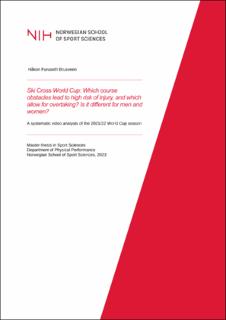| dc.description.abstract | Purpose: The purpose of this study was to assess the risk of injury and to investigate which obstacles (Direction Changes, Jumps, Rollers, Start Straight) lead to an increased risk of injury in World Cup Ski Cross. It also investigated which obstacles allow athletes to overtake other skiers and contribute to attractive competitions.
Methods: The data was collected by video analysis of the 21/22 WC season for men and women. To measure injury risk, Surrogate measures of injury risk were assessed (Crash, Out of Balance, Contact, and Avoided Contact) and to measure overtaking, Rank Shifts were assessed. These Events were analysed using a standardised video rating process. Non-parametric tests were performed to assess differences between obstacles, venues, heats, and genders.
Results: Male athletes generally showed a higher occurrence of Events compared to female athletes. Crashes occurred equally often between the genders. For males, the occurrence of Crash, Out of Balance and Contact was significantly lower in Idre Fjäll compared to other venues. For females, the occurrence of Contact was significantly higher in semi-final 2 compared to quarter-final 1 and semi-final 1. Most Crashes occurred on Direction Changes for males, likely due to increased opponent Contact. For females, the Crashes were equal between obstacle categories. Out of Balance occurred most on jumps for both genders. A higher percentage of Out of Balance situations led to a Crash for females than males. The frequency of obstacles was equal between genders and between venues. Lasty, the possibility to overtake were equal between obstacle categories, suggesting that the course layouts were not a limiting factor for Rank Shifts.
Conclusion: Males generally exhibited more Events than females. For males, the occurrence of Crash was highest in Direction Changes, likely influenced by opponent Contact. For females, the occurrence of Crash was equal between obstacle categories, suggesting that females are Crashing due to the technicality of the course or the obstacles itself. The possibility to overtake was equal between obstacle categories but Rank Shifts may increase the risk of Contact in narrow course sections. This is highlighting the importance of designing accommodating courses with less narrow sections that is suitable for both genders. | en_US |
